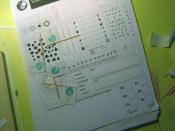What is a job analysis?A job analysis is the systematic process of the activities used to collect information about the duties, responsibilities, necessary skills, accountabilities, outcomes, and work environment of a particular job. You need as much data as possible to put together a job description, which is the frequent outcome of the job analysis. The job analysis may include these activities: reviewing the job responsibilities of current employees, doing Internet research and viewing sample job descriptions online or offline highlighting similar jobs, analyzing the work duties, tasks, and responsibilities that need to be accomplished by the employee filling the position, researching and sharing with other companies that have similar jobs, and articulation of the most important outcomes or contributions needed from the position.
2. Identify the advantages and disadvantages of the observation, structured questionnaire, and diary job analysis methods.
Three methods of job analysis; observation, structured questionnaire and diary job analysis methods.
Observation -This involves collecting data about the job or performance of employees by directly observing them at work. A trained observer observes a worker, recording what the worker does, how the work is done, and how long it takes. There are two types of observation: (1) Continuous observation involves observing a job over a given period of time. (2) Sampling involves observing several incumbents over random, relatively short periods of time. Observation is a simple and frequently used method of job analysis.
Advantages and DisadvantagesAdvantage: data is gathered by watching employees workFirsthand information, Simple to use, Verifies data from other sources, Useful for manual and psychomotor tasksDisadvantage: Observing what you want to see, or pay someone else to do this, time consuming depending on the circumstances, May bias worker performance, Small sample size, Requires skilled observer, Validity & reliability may be problematic, Not useful for jobs consisting...


